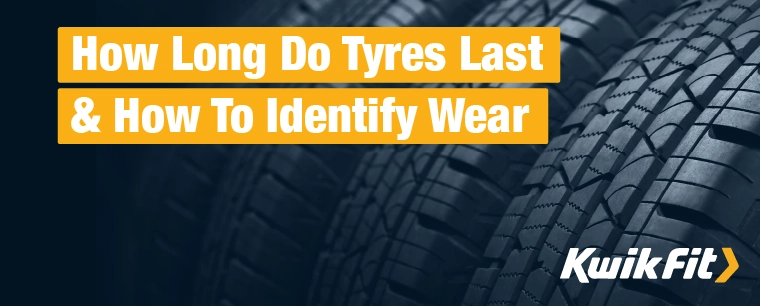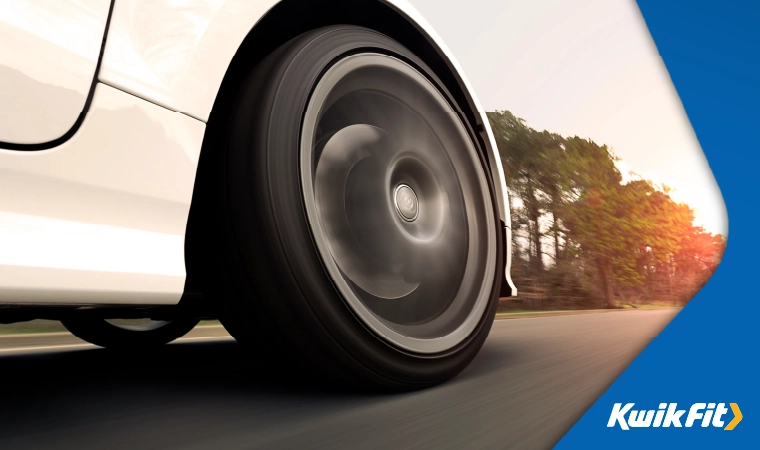How Long Do Tyres Last & How To Identify Wear
Jack Dreyer | Wednesday 18th October 2023 4:00pm

To keep your car performing at its best, your tyres need to be in good condition. Damaged or worn tyres can have a drastic impact on the handling, fuel consumption, and stopping distance of your car. In short, itís really important to monitor the health of your tyres for safer driving and optimal performance.
So how long should your tyres last, and how do you know when they need to be replaced?
How long should tyres last?
Itís hard to provide an exact figure as your tyreís lifespan will vary depending on your driving technique, how often you drive the car, where it is parked most regularly, the type of roads you drive on, how many miles you drive per year, and the quality of the tyre itself. Any one of these things could be the difference between your tyre lasting three years or 10 years.
A general recommendation is that your tyres are changed every 20,000 miles or every 10 years. However, they may need to be changed sooner than this if you notice any of the following:
- The tread is worn down
- Cracks in the rubber
- Air Pressure is being lost more quickly than normal
- 'Wobbly' wheels, particularly at high speeds
Tyre tread wears down over time
Brand new tyres will usually have a tread depth of around eight millimetres. However, this can reduce significantly over time. As the surface of your tyre rubs against the roadís surface, friction is created that will cause the tyre to wear down. The legal limit is 1.6 millimetres, so you mustn't allow your tread depth to drop below this level. In fact, we generally recommend changing a tyre out if it gets below 3mm. The shallower your tyre tread, the longer it could take your vehicle to stop, particularly in wet or icy conditions.
Worn-down tread is generally the first sign that you need new tyres, so keep an eye on it, particularly if you do a lot of mileage.
Cracks in tyres as a sign of damage
Cracks are quite a common issue that can be caused by leaving your car parked for long periods of time or in direct sunlight. The rubber that your tyres are made from is naturally quite pliable, providing the material with a certain amount of elasticity. When you drive your car, the chemical that is applied to make the material even more elastic is released and lubricates your tyres. Therefore, when the vehicle is parked for an extended period of time, the tyres can dry out more quickly, causing cracks to appear. The rubber also loses this elasticity as the tyre ages and if itís regularly subjected to UV rays.
To avoid cracks, drive your car regularly and try to park it in a shady spot, such as a garage. This isnít always possible, but it could increase the lifespan of your tyres.
Tyre air loss caused by cracks or age
If youíre finding that your wheels are losing more air than they should be, you may want to consider shopping around for replacements.
Air loss can be a sign of age, as the tyre develops weaknesses. Air could be lost through the seal around the alloy or through cracks. Itís usual for some pressure to be lost, even in a new tyre, but you should only be putting air in your tyres once a month.
Unbalanced wheels & uneven wear
Finally, Ďwobblyí wheels could also be a sign that itís time to get some new tyres. When your wheels become unbalanced, their weight is distributed unevenly. This can result in excessive tyre wear. If this problem is fixed quickly, you may not need to purchase new tyres, however, the longer you leave it, the more severe the damage will be.
How many miles should tyres last?

Your front tyres should last for around 20,000 miles before being changed and your rear tyres may last longer than this. For example, this means that they should be changed every four years if you average 5,000 miles per year. However, they should be swapped sooner than this if you notice any of the problems listed above.
How long can a spare tyre last?
If you have the space available, you should try to make sure that your vehicle contains a spare wheel should you ever need to change a tyre on a public road. However, the spare should always be a temporary fix and not a permanent solution. Spare tyres are not made to last as long as standard ones.
You shouldnít drive for more than 50 miles on a spare tyre or at more than 50 miles per hour, as it may not be able to withstand the pressure. Spares are there to get you home or to the nearest repair centre, and not for long-term use.
Need a tyre replaced?
If itís time to change a tyre, get in touch with your local Kwik Fit centre for expert advice.
Any facts, figures and prices shown in our blog articles are correct at time of publication.
Featured Articles
Is it Illegal to Drive With One Headlight?
Saturday 19th July 2025
Wondering if itís illegal to drive with one headlight? Learn about the safety risks and penalties of illegal blown bulbs and why you should fix them promptly.
Air Con in EVs & Hybrids: Experts Answer Your Questions
Monday 30th June 2025
Does air con drain EV batteries? Can you use the air con while charging an electric car? Find out the answers to these questions & more from Kwik Fitís experts.
Why Is Your Car Making a Noise? Fixes & Tips
Friday 13th June 2025
When your car starts making unexpected noises, it can certainly be quite disconcerting; it may be nothing to worry about, but hereís what you need to know.









